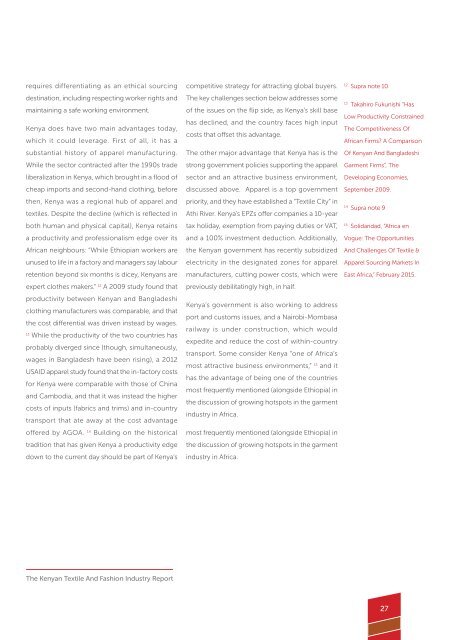You also want an ePaper? Increase the reach of your titles
YUMPU automatically turns print PDFs into web optimized ePapers that Google loves.
equires differentiating as an ethical sourcing<br />
destination, including respecting worker rights and<br />
maintaining a safe working environment.<br />
Kenya does have two main advantages today,<br />
which it could leverage. First of all, it has a<br />
substantial history of apparel manufacturing.<br />
While the sector contracted after the 1990s trade<br />
liberalization in Kenya, which brought in a flood of<br />
cheap imports and second-hand clothing, before<br />
then, Kenya was a regional hub of apparel and<br />
textiles. Despite the decline (which is reflected in<br />
both human and physical capital), Kenya retains<br />
a productivity and professionalism edge over its<br />
African neighbours: “While Ethiopian workers are<br />
unused to life in a factory and managers say labour<br />
retention beyond six months is dicey, Kenyans are<br />
expert clothes makers.” 12 A 2009 study found that<br />
productivity between Kenyan and Bangladeshi<br />
clothing manufacturers was comparable, and that<br />
the cost differential was driven instead by wages.<br />
13<br />
While the productivity of the two countries has<br />
probably diverged since (though, simultaneously,<br />
wages in Bangladesh have been rising), a 2012<br />
USAID apparel study found that the in-factory costs<br />
for Kenya were comparable with those of China<br />
and Cambodia, and that it was instead the higher<br />
costs of inputs (fabrics and trims) and in-country<br />
transport that ate away at the cost advantage<br />
offered by AGOA. 14 Building on the historical<br />
tradition that has given Kenya a productivity edge<br />
down to the current day should be part of Kenya’s<br />
competitive strategy for attracting global buyers.<br />
The key challenges section below addresses some<br />
of the issues on the flip side, as Kenya’s skill base<br />
has declined, and the country faces high input<br />
costs that offset this advantage.<br />
The other major advantage that Kenya has is the<br />
strong government policies supporting the apparel<br />
sector and an attractive business environment,<br />
discussed above. Apparel is a top government<br />
priority, and they have established a “Textile City” in<br />
Athi River. Kenya’s EPZs offer companies a 10-year<br />
tax holiday, exemption from paying duties or VAT,<br />
and a 100% investment deduction. Additionally,<br />
the Kenyan government has recently subsidized<br />
electricity in the designated zones for apparel<br />
manufacturers, cutting power costs, which were<br />
previously debilitatingly high, in half.<br />
Kenya’s government is also working to address<br />
port and customs issues, and a Nairobi-Mombasa<br />
railway is under construction, which would<br />
expedite and reduce the cost of within-country<br />
transport. Some consider Kenya “one of Africa’s<br />
most attractive business environments,” 15 and it<br />
has the advantage of being one of the countries<br />
most frequently mentioned (alongside Ethiopia) in<br />
the discussion of growing hotspots in the garment<br />
industry in Africa.<br />
most frequently mentioned (alongside Ethiopia) in<br />
the discussion of growing hotspots in the garment<br />
industry in Africa.<br />
12<br />
Supra note 10.<br />
13<br />
Takahiro Fukunishi “Has<br />
Low Productivity Constrained<br />
The Competitiveness Of<br />
African Firms? A Comparison<br />
Of Kenyan And Bangladeshi<br />
Garment Firms”, The<br />
Developing Economies,<br />
September 2009.<br />
14<br />
Supra note 9<br />
15<br />
Solidaridad, “Africa en<br />
Vogue: The Opportunities<br />
And Challenges Of Textile &<br />
Apparel Sourcing Markets In<br />
East Africa,” February 2015.<br />
The Kenyan Textile And Fashion Industry Report<br />
27


